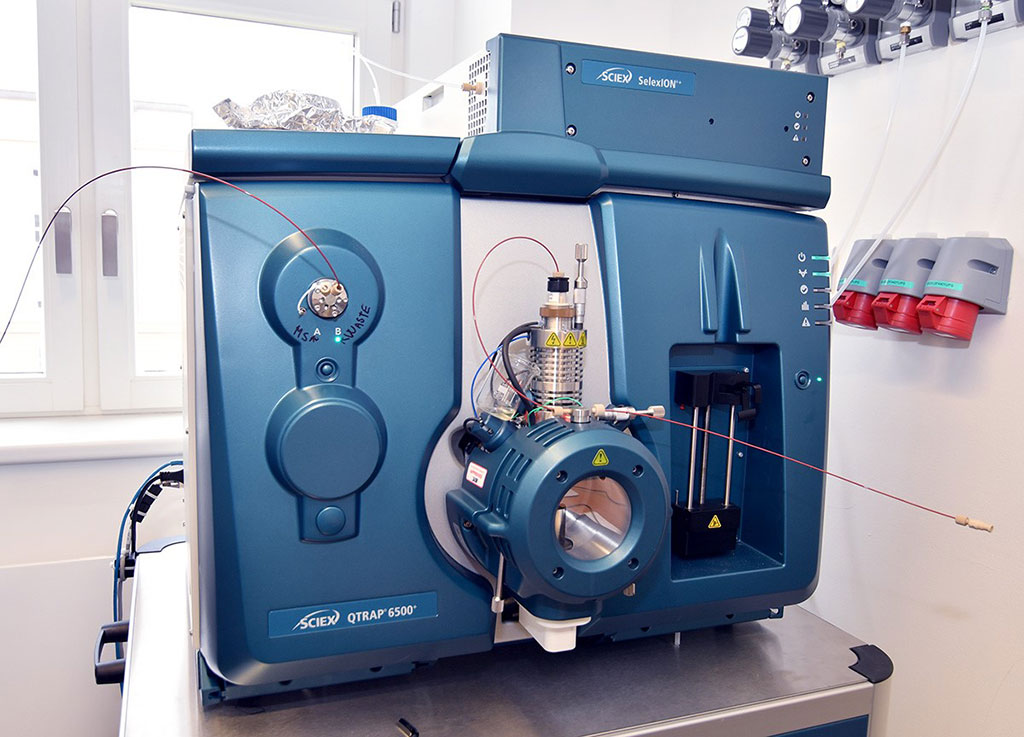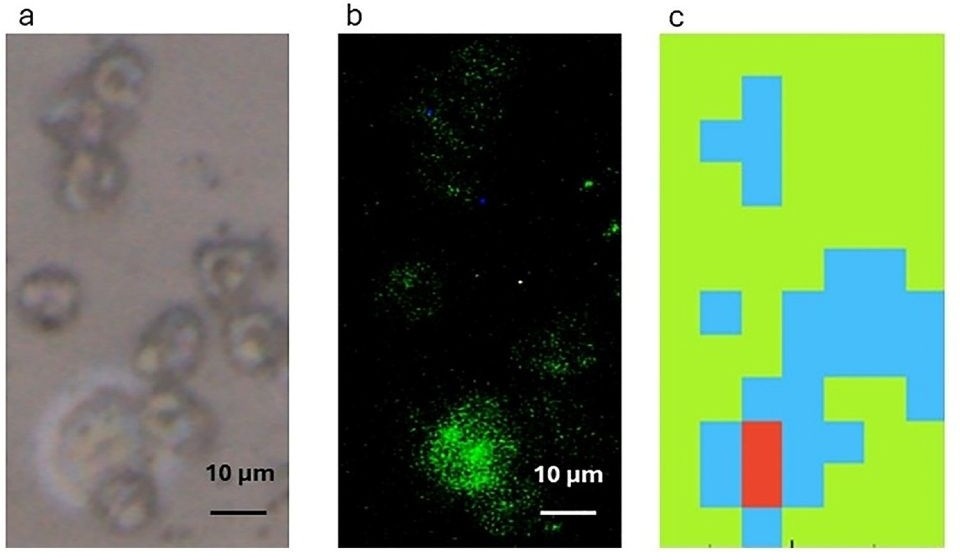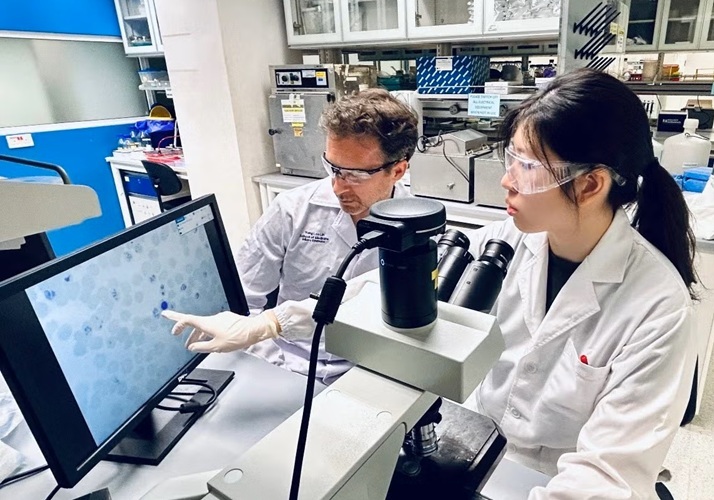Folate, Vitamin B12 Tied to GDM Risk in Early Pregnancy
|
By LabMedica International staff writers Posted on 12 Oct 2021 |

Image: The SCIEX QTRAP 6500+ system combines triple quadrupole mass spectrometry with linear ion trap (LIT) (Photo courtesy of Institute of Organic Chemistry and Biochemistry of the Czech Academy of Sciences)
Gestational diabetes mellitus (GDM) is a common medical disorder in pregnancy, estimated to affect more than 20 million pregnancies worldwide, and causes significant short- and long-term consequences to both the women and their offspring.
Folate and B12 are essential micronutrients for the metabolism of single carbon atoms (known as 1-C metabolism) and these pathways are involved in DNA methylation and synthesis of amino acids, nucleic acids and lipids. Low vitamin B12 and low/high folate levels may contribute to GDM risk, but there is conflicting evidence.
Health Scientist at the Warwick Medical School (Coventry, UK) carried out a prospective, multi-center, multi-ethnic cohort study of 4,746 participants who were pregnant women aged between 18 and 45 years who were at less than 16 weeks of gestation. A random blood sample at booking and fasting and two hour blood samples at Oral Glucose Tolerance Test (OGTT) using 75 grams of anhydrous glucose after an overnight fast of at least 10 hours were taken.
Plasma glucose was determined by the hexokinase enzymatic method using a Synchron CX7 auto-analyzer (Beckman Coulter, Fullerton, CA, USA). Serum B12 and folate were measured by electro-chemiluminescent immunoassay (Roche Cobas analyzer, Roche Diagnostics, Burgess Hill, UK). Plasma total homocysteine (tHcy) was determined by stable isotopic dilution analysis using a Shimadzu HPLC system (Milton Keynes, UK) with an auto-sampler coupled to the detection system of an AB Sciex 6500 QTrap tandem mass spectrometer (liquid chromatography mass spectrometry [LCMS]) (Applied Biosystems, Warrington, UK).
The investigators reported that GDM prevalence was between 12.5% and 14.7%. Folate deficiency (1.3%) was rare but B12 insufficiency (42.3% at <220 pmol/L) and folate excess (36.5%) were common in early pregnancy. Early pregnancy median B12 levels were lower and folate levels higher, in women who were diagnosed with GDM at 26–28 weeks and B12 was negatively associated with fasting plasma glucose. Total homocysteine was inversely associated with blood glucose level and risk of GDM. The associations strengthened when adjusted for BMI, suggesting that the total homocysteine effect on blood glucose level/GDM is independent of BMI, B12 and folate.
The authors concluded that B12 insufficiency and folate excess were common in early pregnancy. Low B12 and high folate levels in early pregnancy were associated with small but statistically significant changes in maternal blood glucose level and higher relative risk (RR) of GDM. The findings warrant additional studies on the role of unmetabolized folic acid in glucose metabolism and investigating the effect of optimizing early pregnancy or pre-conception B12 and folate levels on subsequent hyperglycemia. The study was originally published on July 22, 2021 in the journal Diabetologia.
Related Links:
Warwick Medical School
Beckman Coulter
Roche Diagnostics
Shimadzu
Applied Biosystems
Folate and B12 are essential micronutrients for the metabolism of single carbon atoms (known as 1-C metabolism) and these pathways are involved in DNA methylation and synthesis of amino acids, nucleic acids and lipids. Low vitamin B12 and low/high folate levels may contribute to GDM risk, but there is conflicting evidence.
Health Scientist at the Warwick Medical School (Coventry, UK) carried out a prospective, multi-center, multi-ethnic cohort study of 4,746 participants who were pregnant women aged between 18 and 45 years who were at less than 16 weeks of gestation. A random blood sample at booking and fasting and two hour blood samples at Oral Glucose Tolerance Test (OGTT) using 75 grams of anhydrous glucose after an overnight fast of at least 10 hours were taken.
Plasma glucose was determined by the hexokinase enzymatic method using a Synchron CX7 auto-analyzer (Beckman Coulter, Fullerton, CA, USA). Serum B12 and folate were measured by electro-chemiluminescent immunoassay (Roche Cobas analyzer, Roche Diagnostics, Burgess Hill, UK). Plasma total homocysteine (tHcy) was determined by stable isotopic dilution analysis using a Shimadzu HPLC system (Milton Keynes, UK) with an auto-sampler coupled to the detection system of an AB Sciex 6500 QTrap tandem mass spectrometer (liquid chromatography mass spectrometry [LCMS]) (Applied Biosystems, Warrington, UK).
The investigators reported that GDM prevalence was between 12.5% and 14.7%. Folate deficiency (1.3%) was rare but B12 insufficiency (42.3% at <220 pmol/L) and folate excess (36.5%) were common in early pregnancy. Early pregnancy median B12 levels were lower and folate levels higher, in women who were diagnosed with GDM at 26–28 weeks and B12 was negatively associated with fasting plasma glucose. Total homocysteine was inversely associated with blood glucose level and risk of GDM. The associations strengthened when adjusted for BMI, suggesting that the total homocysteine effect on blood glucose level/GDM is independent of BMI, B12 and folate.
The authors concluded that B12 insufficiency and folate excess were common in early pregnancy. Low B12 and high folate levels in early pregnancy were associated with small but statistically significant changes in maternal blood glucose level and higher relative risk (RR) of GDM. The findings warrant additional studies on the role of unmetabolized folic acid in glucose metabolism and investigating the effect of optimizing early pregnancy or pre-conception B12 and folate levels on subsequent hyperglycemia. The study was originally published on July 22, 2021 in the journal Diabetologia.
Related Links:
Warwick Medical School
Beckman Coulter
Roche Diagnostics
Shimadzu
Applied Biosystems
Latest Clinical Chem. News
- Compact Raman Imaging System Detects Subtle Tumor Signals
- Noninvasive Blood-Glucose Monitoring to Replace Finger Pricks for Diabetics
- POC Breath Diagnostic System to Detect Pneumonia-Causing Pathogens
- Online Tool Detects Drug Exposure Directly from Patient Samples
- Chemical Imaging Probe Could Track and Treat Prostate Cancer
- Mismatch Between Two Common Kidney Function Tests Indicates Serious Health Problems
- VOCs Show Promise for Early Multi-Cancer Detection
- Portable Raman Spectroscopy Offers Cost-Effective Kidney Disease Diagnosis at POC
- Gold Nanoparticles to Improve Accuracy of Ovarian Cancer Diagnosis
- Simultaneous Cell Isolation Technology Improves Cancer Diagnostic Accuracy
- Simple Non-Invasive Hair-Based Test Could Speed ALS Diagnosis
- Paper Strip Saliva Test Detects Elevated Uric Acid Levels Without Blood Draws
- Prostate Cancer Markers Based on Chemical Make-Up of Calcifications to Speed Up Detection
- Breath Test Could Help Detect Blood Cancers
- ML-Powered Gas Sensors to Detect Pathogens and AMR at POC
- Saliva-Based Cancer Detection Technology Eliminates Need for Complex Sample Preparation
Channels
Molecular Diagnostics
view channel
Urine Test Could Reveal Real Age and Life Span
Chronological age does not always reflect how quickly the body is aging, as biological age is shaped by genetics, stress, sleep, nutrition, and lifestyle factors such as smoking. A higher biological age... Read more
Genomic Test Identifies African Americans at Risk for Early Prostate Cancer Recurrence
Prostate cancer is one of the most commonly diagnosed cancers in men and a leading cause of cancer-related death, particularly in the United States. African American men face a disproportionately higher... Read moreHematology
view channel
MRD Tests Could Predict Survival in Leukemia Patients
Acute myeloid leukemia is an aggressive blood cancer that disrupts normal blood cell production and often relapses even after intensive treatment. Clinicians currently lack early, reliable markers to predict... Read more
Platelet Activity Blood Test in Middle Age Could Identify Early Alzheimer’s Risk
Early detection of Alzheimer’s disease remains one of the biggest unmet needs in neurology, particularly because the biological changes underlying the disorder begin decades before memory symptoms appear.... Read more
Microvesicles Measurement Could Detect Vascular Injury in Sickle Cell Disease Patients
Assessing disease severity in sickle cell disease (SCD) remains challenging, especially when trying to predict hemolysis, vascular injury, and risk of complications such as vaso-occlusive crises.... Read more
ADLM’s New Coagulation Testing Guidance to Improve Care for Patients on Blood Thinners
Direct oral anticoagulants (DOACs) are one of the most common types of blood thinners. Patients take them to prevent a host of complications that could arise from blood clotting, including stroke, deep... Read moreImmunology
view channel
Ultrasensitive Liquid Biopsy Demonstrates Efficacy in Predicting Immunotherapy Response
Immunotherapy has transformed cancer treatment, but only a small proportion of patients experience lasting benefit, with response rates often remaining between 10% and 20%. Clinicians currently lack reliable... Read more
Blood Test Could Identify Colon Cancer Patients to Benefit from NSAIDs
Colon cancer remains a major cause of cancer-related illness, with many patients facing relapse even after surgery and chemotherapy. Up to 40% of people with stage III disease experience recurrence, highlighting... Read moreMicrobiology
view channel
New UTI Diagnosis Method Delivers Antibiotic Resistance Results 24 Hours Earlier
Urinary tract infections affect around 152 million people every year, making them one of the most common bacterial infections worldwide. In routine medical practice, diagnosis often relies on rapid urine... Read more
Breakthroughs in Microbial Analysis to Enhance Disease Prediction
Microorganisms shape human health, ecosystems, and the planet’s climate, yet identifying them and understanding how they are related remains a major scientific challenge. Even with modern DNA sequencing,... Read morePathology
view channel
Genetics and AI Improve Diagnosis of Aortic Stenosis
Aortic stenosis is a progressive narrowing of the aortic valve that restricts blood flow from the heart and can be fatal if left untreated. There are currently no medical therapies that can prevent or... Read more
AI Tool Simultaneously Identifies Genetic Mutations and Disease Type
Interpreting genetic test results remains a major challenge in modern medicine, particularly for rare and complex diseases. While existing tools can indicate whether a genetic mutation is harmful, they... Read more
Rapid Low-Cost Tests Can Prevent Child Deaths from Contaminated Medicinal Syrups
Medicinal syrups contaminated with toxic chemicals have caused the deaths of hundreds of children worldwide, exposing a critical gap in how these products are tested before reaching patients.... Read more
Tumor Signals in Saliva and Blood Enable Non-Invasive Monitoring of Head and Neck Cancer
Head and neck cancers are among the most aggressive malignancies worldwide, with nearly 900,000 new cases diagnosed each year. Monitoring these cancers for recurrence or relapse typically relies on tissue... Read moreTechnology
view channel
Pioneering Blood Test Detects Lung Cancer Using Infrared Imaging
Detecting cancer early and tracking how it responds to treatment remains a major challenge, particularly when cancer cells are present in extremely low numbers in the bloodstream. Circulating tumor cells... Read more
AI Predicts Colorectal Cancer Survival Using Clinical and Molecular Features
Colorectal cancer is one of the most common and deadly cancers worldwide, and accurately predicting patient survival remains a major clinical challenge. Traditional prognostic tools often rely on either... Read moreIndustry
view channel
BD and Penn Institute Collaborate to Advance Immunotherapy through Flow Cytometry
BD (Becton, Dickinson and Company, Franklin Lakes, NJ, USA) has entered into a strategic collaboration with the Institute for Immunology and Immune Health (I3H, Philadelphia, PA, USA) at the University... Read more







 assay.jpg)

 Analyzer.jpg)









